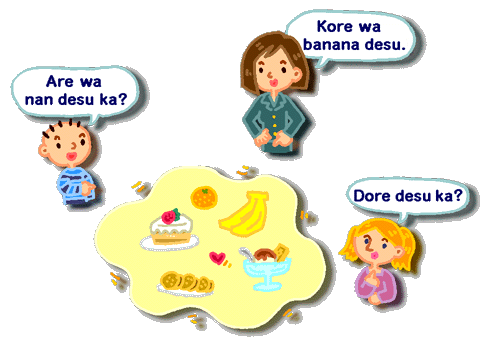Page 3


- Past affirmative (yes) and negative (no) form of
 (to
be): (to
be):
| Affirmative |
|
|
Negative |
|
| Non-past |
 |
desu |
 |
dewa
arimasen |
| Past |
 |
deshita |
  |
dewa
arimasen deshita |
As you learned in Lesson 4, Japanese verbs have a
non-past form, used for the present and the future, and a past form.
You make the negative of the past tense by attaching  (deshita)
to the negative non-past form. (deshita)
to the negative non-past form.

Kino wa Lucy no tanjobi deshita. |
Yesterday
was Lucy's birthday. |
    
Purezento wa seta deshita. |
The present
was a sweater. |
   
Shatsu dewa arimasen deshita. |
It was
not a shirt. |
 (suki) like, be fond of
(suki) like, be fond of
 ,
or "like," is classified as a noun, not an adjective. This
means you have to use the particle ,
or "like," is classified as a noun, not an adjective. This
means you have to use the particle  to mark the thing that is liked.
to mark the thing that is liked.
      
Kenta wa sakka ga suki desu. |
Kenta likes
soccer. |
        
Lucy wa tenisu to sakka ga suki desu. |
Lucy likes
tennis and soccer. |
      
Kenta wa tenisu ga suki dewa arimasen. |
Kenta does
not like tennis. |

-
 (to): and
(to): and
 is used like the word "and" in English. When you combine
many things in English, you say "A, B, C, D and E," but
in Japanese you use
is used like the word "and" in English. When you combine
many things in English, you say "A, B, C, D and E," but
in Japanese you use  every time: "A to B to C to D to E."
every time: "A to B to C to D to E."
     
Orenji to banana o tabemashita. |
( I ) ate
an orange and a banana. |
       
Orenji to banana to kukki o tabemashita. |
( I ) ate
an orange, a banana and cookies. |

       (kore, sore, are, dore): this and that...
(kore, sore, are, dore): this and that...

|



